# User actions
Flows in the user actions area consist of a manual trigger and of at least one or more services. Optionally, you can make flows more complex by using branches.
# Select trigger
For user actions, you don't select a trigger for a component, but instead define a button for ELO clients. This button starts the flow.
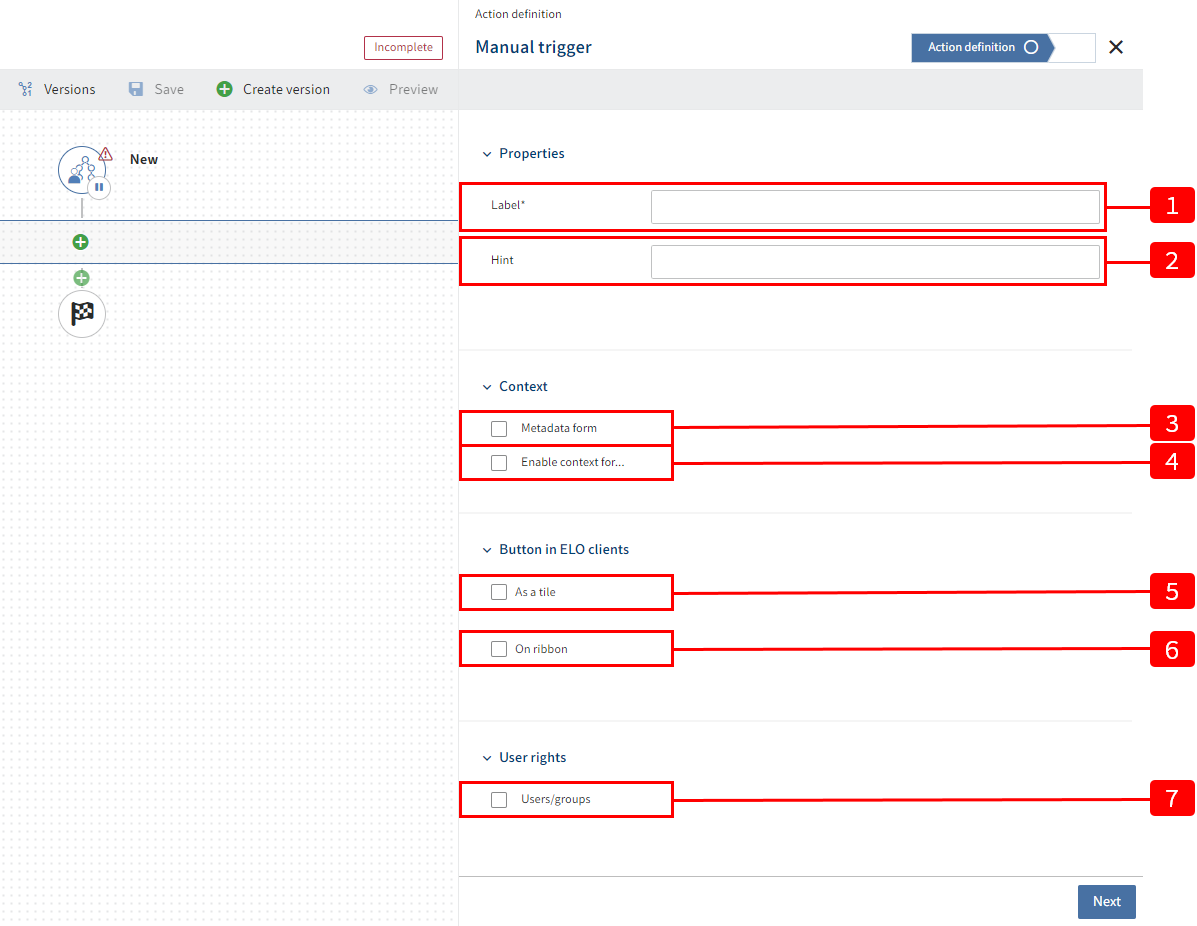
Open the trigger in the node editor by selecting the trigger node.
The Action definition tab opens.
You have the following configuration options:
1 Select label: Button title shown in the ELO clients
2 Add tip: Tooltip text for the button you've created
3 Configure metadata form: Configure the relevant metadata form for this button. The button is only enabled if the selected element has the defined metadata form.
Information
Under Components > General information, you will find more information on completing fields with gen. 1 and gen. 2 metadata in the flow designer.
4 Enable context for…: This button is only enabled if the selected element is a folder and/or a document. After activation, the object ID of the object selected in ELO Flows is provided.
5 Show as a tile: The user action is shown as a tile in the My ELO work area. You can configure an icon for it.
6 Show on ribbon: Defines the position of the button on the ribbon in the ELO client. Select the tab, the group, and the icon.
7 Only show in certain ELO clients: Controls which clients the button is shown in. If nothing is selected here, the button is shown in all clients.
8 Users/groups: Defines which users and groups the button is shown to. If this option is not enabled, the button is shown to all users.
Complete at least the mandatory fields.
Select Next to confirm your entries.

The Summary tab opens. All the settings are shown once again.
1 Node key: Name of the node shown in square brackets in the flow designer
2 Node description: More detailed description of the node
3 Enable synchronous feedback: Executes the flow as a synchronous flow.
Information
You can find more information on this topic in the Synchronous flows section.
Select Done to finish configuring the trigger.
Please note
With the Done action, the configurations are only saved in the configuration area and are not yet applied to the flow.
In the flow designer, select Save to apply the entries in the configuration area to the flow.
# Add activities
Via Add activity, define what to show when the button is selected in the client.
Information
Activities are optional.
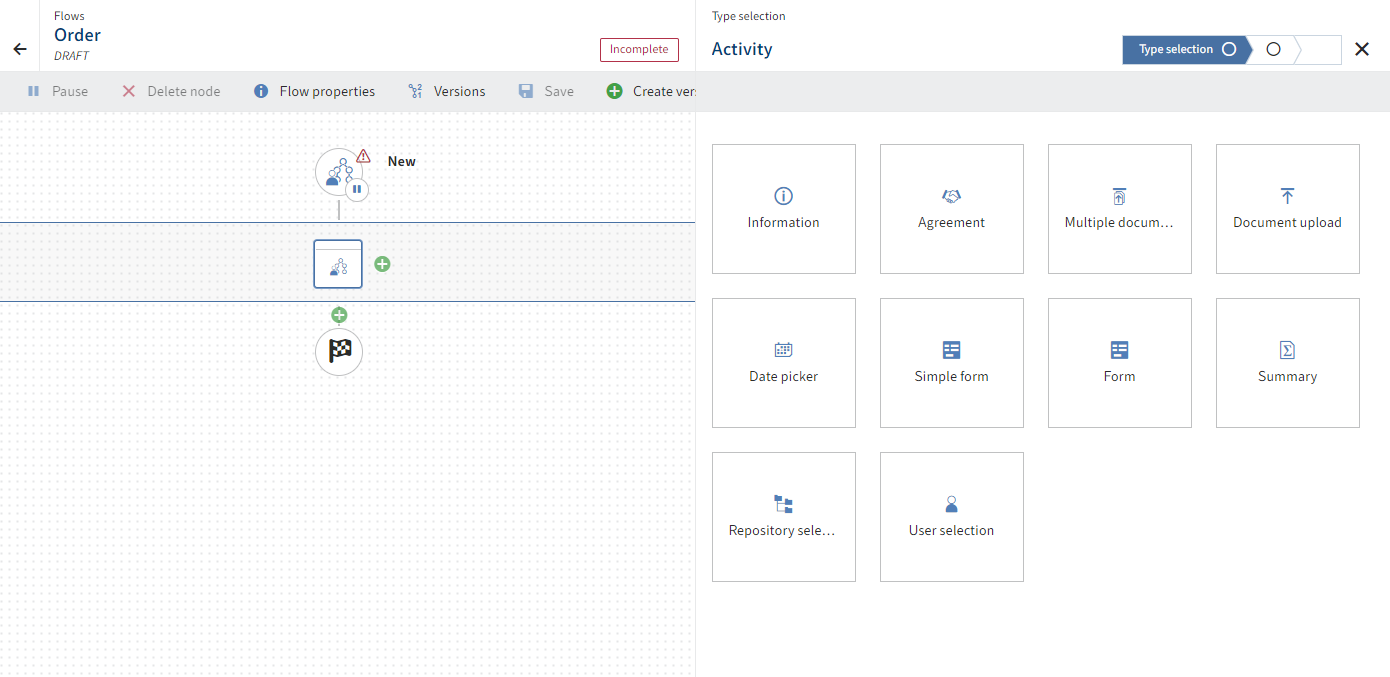
To add an activity, select the plus icon next to the trigger node.
All activities currently available are shown on the Activity pages.
Information: Shows a purely informational text. This activity does not provide any data.
Agreement: Here, you can define check boxes to reach an agreement with the users. For example, a data privacy agreement, license agreement, etc.
Multiple document upload: With this activity, you can prompt the user to upload multiple documents. You can save it in ELO with the ELO objects and metadata, for example.
Document upload: With this activity, you can prompt users to upload a document. You can save it in ELO with the ELO objects and metadata, for example.
Date picker: Shows a calendar. Users can select a specific date or date interval here.
Simple form: Shows a form. For example, you can implement a contact form with this activity.
Summary: The summary shows all data from previous activities. You can place this at the end to give users a final overview.
Repository selection: With the Repository selection activity, you can prompt users to select an element from the ELO repository. In the settings, set the root element to define the level at which users are offered a selection.
User selection: With this activity, you can prompt users to select an ELO user and/or ELO group from the ELO system.
Information
You can select localization keys for activities with text or titles visible to the user in the client.
If you configure flows outside of ELO packages, you can only use keys available in the system.
The keys can come from the following sources:
- Keys already configured via ELO packages
- Keys filed in the repository as properties files
For flows you edit within ELO packages, you can also create new localization keys and configure existing ones. The localization is configured for the active language of the ELO Administration Console.
Enter a localization key.
Alternative: Select an existing localization key from the drop-down menu.
Enter a name in the Localization field.
Select the floppy disk icon to assign the name to the localization and save it.
Select an activity.
Option 1: To map a series of activities, these can be chained. Add another activity.
Option 2: Delete the existing activity by selecting Delete node on the ribbon.
The button and activities in the ELO client can be shown as follows:
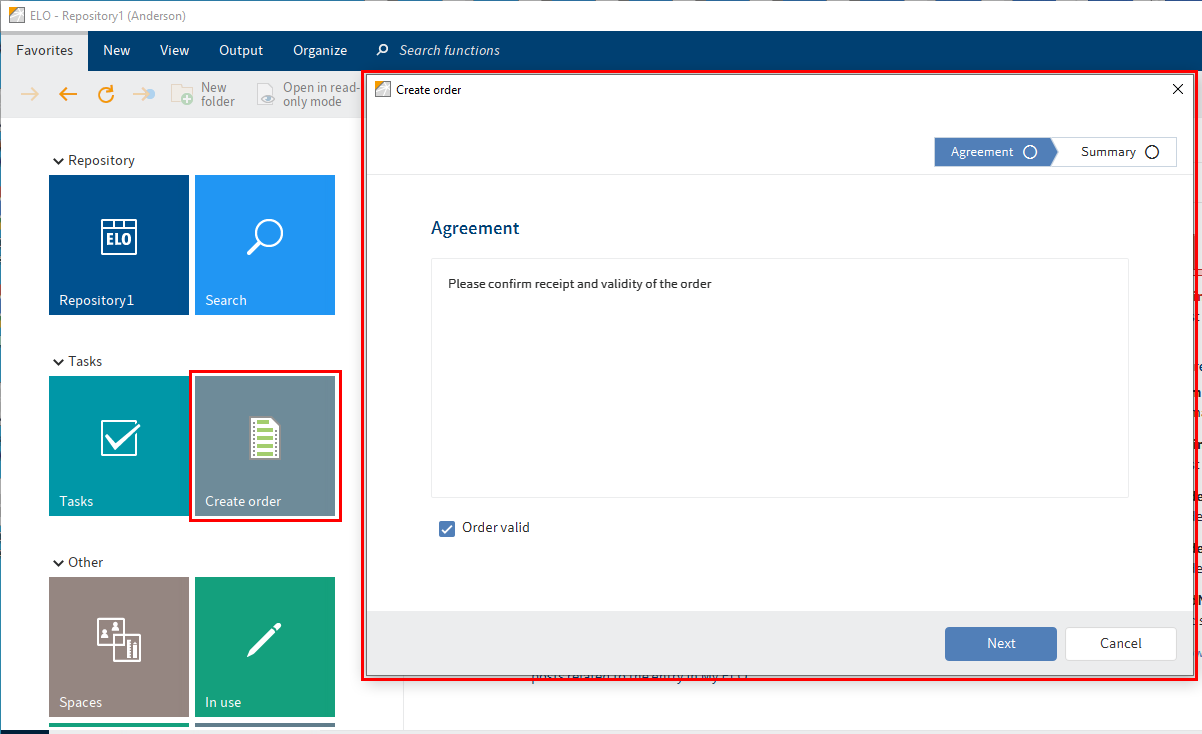
Please note
The button is only shown if the status of the flow is Active. You have to define at least one service.
Once you have defined activities, you can create your first branch or service.
Information
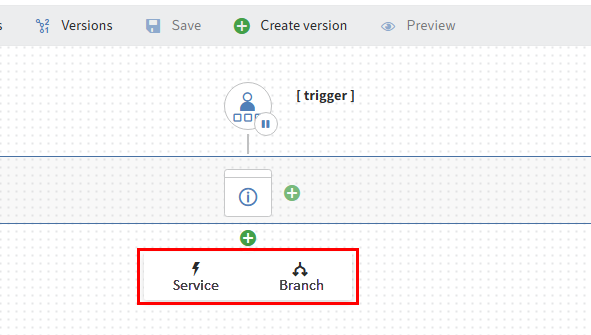
Before each step, you can decide whether to create a branch with a true-false condition or to add a service. You can nest branches in other branches or continue with services.
You will find more information on branches in ELO Flows in this documentation under Advanced flow.
# Add service

To add a service, select the plus icon next to the trigger node and select Service.
The configuration area with the available components opens for the new node.
Select a component.
By selecting the component, you are automatically taken to the next tab with the services available for the component.
Select the desired service.
Information
Services can be listed individually (lightning icon) or in groups (folder icon).
Selecting the service automatically takes you to the next tab with the user settings.
Select a user connection.
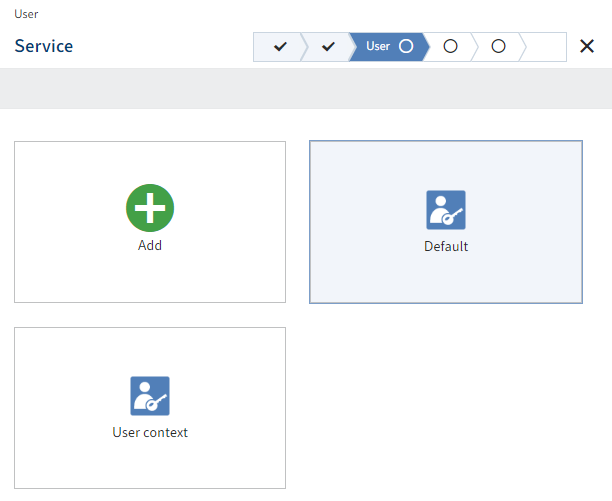
Information
If you've already configured a user under Credentials, you can select the user here. Otherwise, you can select the default connection or add a new one.
Confirm your selection with Next.
The Settings tab appears.
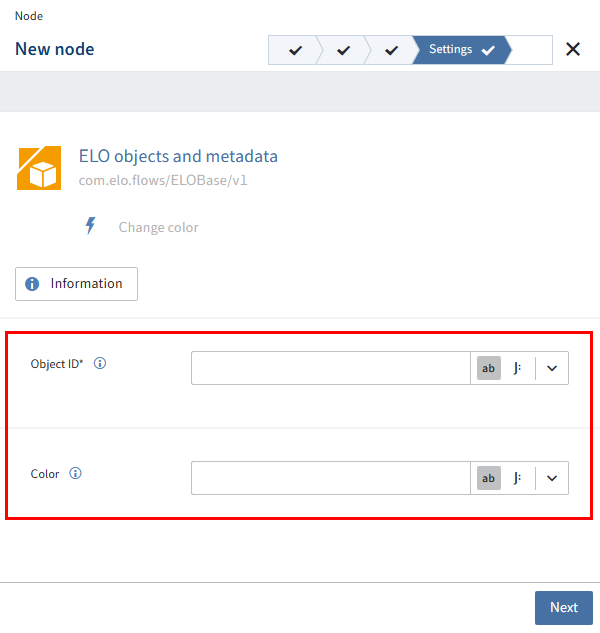
Configure custom data for the service.
Information
You can complete the fields with static or dynamic values. Dynamic evaluation is performed based on JSONata. With this transformation language, you can access event objects of the previous nodes and triggers in addition to using transformations or simple functions.
You will find more about the use of JSONata in ELO Flows under JSONata editor.
Information
Some services offer you the output schema function. That means that this service offers a dynamic output object. This can be the case with metadata objects, for example.
Example: You file a document with the E-mail metadata form and want to access a field of this document in a subsequent node. As ELO Flows initially does not know which fields are relevant for this document, the service only offers the parent object (e.g. objKeys and aspectData) in the subsequent object without access to the individual metadata fields.
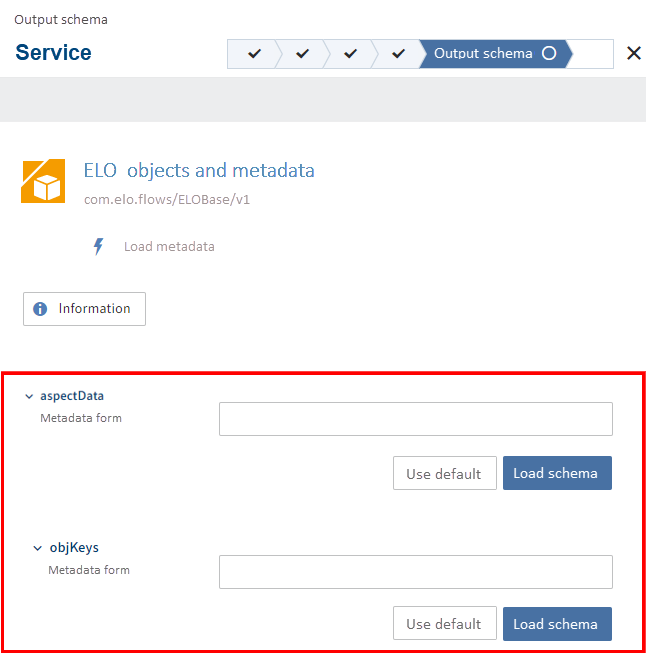
So that ELO Flows knows which metadata fields the output object has, you can either use a standard metadata form or load a special one. In the metadata form field, enter E-mail and select Load schema. The schema is loaded with the appropriate metadata form properties.
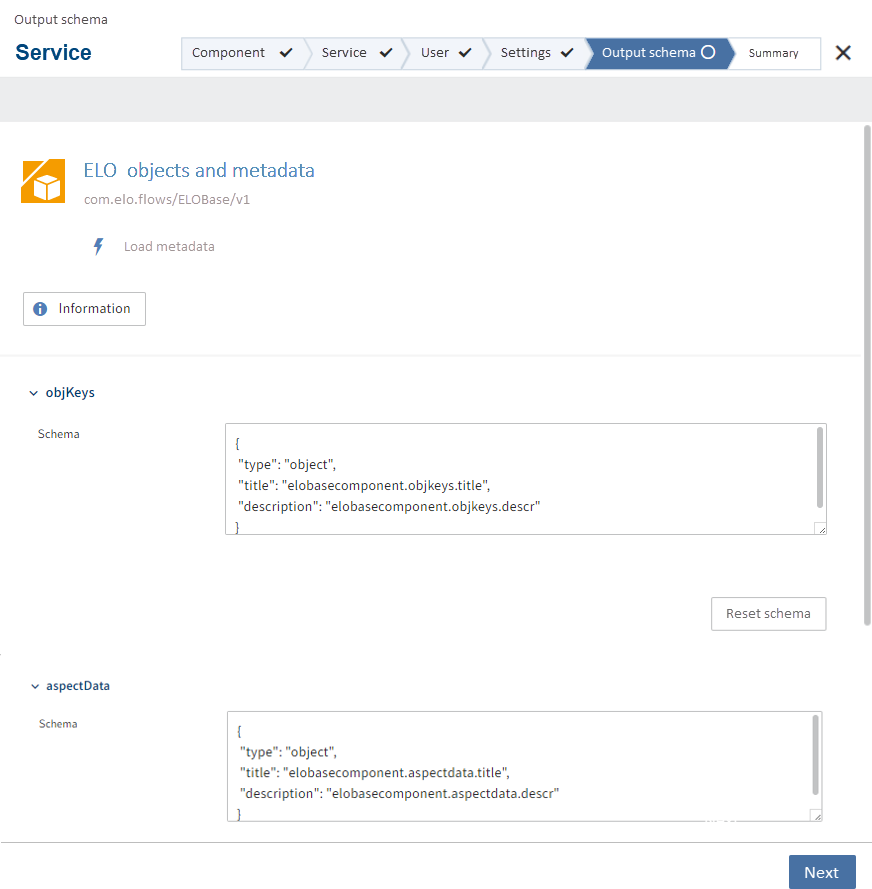
Alternative: You can also select Use default. The object is then output with the default properties, and the properties of the object have to be accessed manually via JSONata.
If applicable, confirm the settings on the Output schema page by selecting Next.

The Summary tab opens. All the settings are shown once again.
1 Node key: Name of the node shown in square brackets in the flow designer
2 Node description: More detailed description of the node
3 Do not trigger an error if the service fails.: The entire flow runs, even if this service fails. This function is for test purposes. The result data for this service may be faulty or unavailable.
Select Done to apply the service settings in the configuration area.
Please note
With the Done action, the configurations are only saved in the configuration area and are not yet applied to the flow.
In the flow designer, select Save to apply the entries in the configuration area to the flow.
Save the entire flow.
The status display now changes to Active.